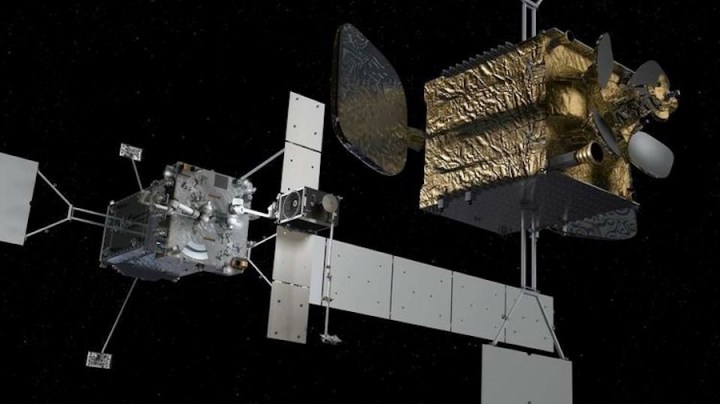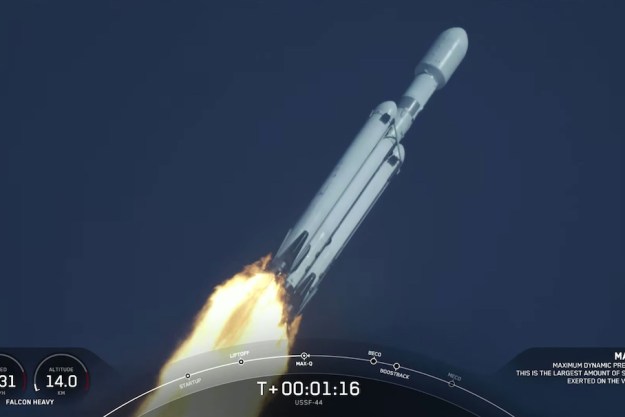
DARPA, the Defense Advanced Research Projects Agency that’s responsible for developing emerging technologies for the U.S. military, is building a new high-tech spacecraft — and it’s armed. In an age of Space Force and burgeoning threats like hunter-killer satellites, this might not sound too surprising. But you’re misunderstanding. DARPA’s new spacecraft, currently “in the thick of it” when it comes to development, is armed. As in, it has arms. Like the ones you use for grabbing things.
Armed robots aren’t new. Mechanical robot arms are increasingly widespread here on Earth. Robot arms have been used to carry out complex surgery and flip burgers. Attached to undersea exploration vehicles, they’ve been used to probe submerged wrecks. They’ve been used to open doors, defuse bombs, and decommission nuclear power plants. They’re pretty darn versatile. But space is another matter entirely.
The trouble with satellites
To understand the problem, imagine this scenario: You buy a supercar. It’s got every possible modern luxury, from its use of premium materials like titanium and carbon fiber-reinforced epoxy composites to its top-of-the-range engine, which purrs like the world’s most expensive kitten. Only there’s a catch. Although the car has been built to last, once you’ve driven it off the sales lot, you’re no longer allowed to repair or even tinker with it. Nothing. Nada. Zip. It’s not even possible to take it to the gas station when it needs to be refueled. Crazy, right? Even the most extravagant of sports stars, rappers or international arms dealers would probably think twice about that “deal.”
This is entirely analogous to the situation we’re in with some of today’s satellites. And with price tags that can exceed a billion dollars, today’s top-of-the-line satellites make Bugattis and McLarens look like chump change.
“The current way that we operate spacecraft, they’re launched and they are [then] essentially on their own for the rest of their lives,” Joe Parrish, program manager for DARPA’s Robotic Servicing of Geosynchronous Satellites (RSGS) program, told Digital Trends. “If something goes wrong, or if they run out of fuel or some other consumable, there’s no other method to go and improve those spacecraft — either by way of repair or replenishment or by placing new capabilities … that perhaps may be 20 years on, where the technologies on them are no longer the best ones available.”
That’s where DARPA’s solution comes into play. “With RSGS, we have a spacecraft that looks similar to a commercial satellite, but has two robot arms on it,” Parrish said. “And those robot arms have interchangeable tools that allow a variety of different operations that include grasping onto what we call the client spacecraft [and performing repair tasks.]”
Part robot handyman, part tow truck
Should all go to plan, it will mean that, for the first time in history, it’s possible to carry out “dexterous manipulation” tasks to help fix satellites in geosynchronous orbit. The RSGS spacecraft will hang out in orbit until it is called into action. It will then navigate to the “client spacecraft” in question, latch onto it autonomously using machine vision A.I., and then set about carrying out external maintenance work to extend that satellite’s life span, enhance resilience, and improve reliability for future operations. It could even be used to install self-contained payloads.

RSGS’s two arms are each approximately 2 meters in length, around twice the length of an adult human arm. In place of a five-fingered, human-style hand, it’s kitted out with a series of interchangeable tools specialized for whichever task it is supposed to carry out. Those tasks might involve nudging a stuck solar array or antenna here or there.
It could even grip onto dying satellites and pull them, like a “sort of tow truck,” into graveyard orbit 300 kilometers above normal geostationary orbit. This could allow satellite companies to extend the life of their space assets by “another few years,” Parrish said.
“Imagine freezing, thawing, freezing, thawing, freezing, thawing, over and over again.”
“Typically what happens with geostationary spacecraft is they run out of what’s called station-keeping fuel,” he said. “This is the fuel that keeps them in position, so that a satellite that’s stationed over the United States or the Middle East or wherever it’s doing its job stays there. That requires a certain amount of fuel every year to be used as propellant. Eventually, they run out of fuel, usually 15 to 20 years into their lifetime. Then they’re supposed to be disposed of by moving into a different orbit, moving out of the way so that another spacecraft can go into that orbital slot in geosynchronous orbit.”
For this reason, satellites retain an extra bit of fuel, allowing them to make this final journey. Instead of this, Parrish said that RSGS could be used to transport the defunct satellites to their final resting place after they use up every last drop of station-keeping fuel.
The challenges of space
None of this is straightforward, of course. Parrish explained some of the challenges that exist with building and launching the first RSGS spacecraft. For one thing, space is a pretty darn inhospitable environment. Even compared to some of the more hazardous terrain on Earth, geostationary orbit comes with a slew of new challenges.

“[You] go from a temperature that would boil water down to well below a temperature that would freeze water,” he said. “That happens many, many times throughout a mission. Imagine freezing, thawing, freezing, thawing, freezing, thawing, over and over again. The temperature extremes are very different than what you would encounter in a laboratory environment.”
There is also the issue of damage from atmospheric radiation, while the vacuum of space means that traditional methods of lubricating components such as motors and gears simply won’t work. Any lubricants used on conventional robot arms would be boiled off in an instant.
“It turns out in practice that humans have great difficulty teleoperating robots with that amount of time delay.”
Then there’s the challenge of maneuvering the RSGS spacecraft in orbit. Satellites are a lot of things, but one thing they are not is particularly nimble and capable of zipping around like cars on a freeway. RSGS is no ordinary satellite, however. “We carry additional thrusters and additional fuel that makes us much more maneuverable than a typical spacecraft,” Parrish explained.
The robot is controlled using a combination of autonomous technology and step-by-step, human-programmed instructions. Plans to employ remote-control were torpedoed by the time delay in sending instructions 37,000 kilometers above Earth.
“It turns out in practice that humans have great difficulty teleoperating robots with that amount of time delay,” Parrish said. “They can handle a quarter of a second of time delay from the time they input something to the time they see the robot moving in that direction to perform the command. Two seconds kind of takes us out of being able to joystick the robot.”
Launch is just around the corner
At present, the team is hard at work building the robot arms, in addition to developing other project components like the various gripper tools and onboard cameras. Testing is planned to take place late next year or early in 2022. After that, the plan is to launch the robot mechanic into orbit in 2023. “That may sound far away to some, but to me as the project manager, it’s right around the corner,” Parrish said.
Don’t expect it to remain lonely, though. We are hoping that if the first RSGS is successful, that will spawn numerous additional ones, he said.
With no shortage of satellites currently in orbit, and lots more to launch in the near future, this is likely to be one robot that’s got no shortage of work available.
Editors' Recommendations
- SpaceX’s Starship reaches orbit on third test flight
- How to watch the SpaceX Falcon Heavy launch U.S. space plane to orbit
- This team of legged robots could be the future of Mars exploration
- Space bags are the next big idea to clean up orbital junk
- Watch SpaceX blast a 5-tonne Intelsat satellite to orbit


